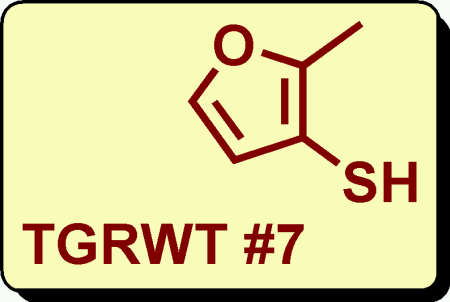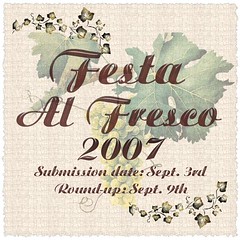
Die Gastgeberin der dieswöchigen Kräuterküche WHB # 86 ist Ulrike von Küchenlatein in Kronshagen, Deutschland.
The host of this week´s herb blogging WHB # 86 is Ulrike from Küchenlatein from Kronshagen, Germany. Felsenbirnengelee
Felsenbirnengelee
Heute habe ich 1,5 kg Felsenbirnchen geerntet. Das ergab, nachdem die Früchte beim Kochen aufgeplatzt sind, 1 Liter dickflüssigen Saft. Aromatisiert habe ich diesmal mit einem Stengel Estragon, der dem Gelee einen Hauch Anisaroma mitgibt.
Zutaten
1,5 kg Felsenbirnchen
1 kg Gelierzucker
1 Stengel Estragon
Zubereitung
Die Früchte kochend platzen lassen und Estragon zufügen. Durch ein Sieb passieren, um die harte Haut und die Kerne zu entfernen, da sie blausäurehaltig sind. Den Saft mit dem Zucker in einen Topf geben und aufkochen. Für 4 Minuten sprudelnd kochen lassen. In vorbereitete Gläser füllen und sofort verschließen. Stürzen, damit sie luftdicht abschließen. Ergibt 8 Gläser. Saskatoon jelly
Saskatoon jelly
Today I harvested 1,5 kg saskatoon berries or June berries. They were cooked to a litre thick liquid. To give it a special note I used tarragon this year.
Ingredients
1,5 kg berries
1 kg sugar for jelly
1 stem tarragon
Preparation
Bring the berries to burst while cooking add the taragon, pass them through a sieve to get rid of the hard skin and the stones containing hydrocyanic acid. Give liquid and sugar into a pot and let it cook bubbly for 4 Minutes. Fill the jelly immediately into prepared glasses, close them and turn them with top on a shovel to make them close firmly. This produced 8 glasses.  Kalyn von Kalyn´s Kitchen die Mutter dieses Ereignisses möchte Neues erfahren über Kräuter, Gemüse und Füchte. Ich stelle die Felsenbirne in den Mittelpunkt, da sie in Deutschland meist nur als Zierstrauch bekannt ist und erst jetzt als Delikatesse gilt.
Kalyn von Kalyn´s Kitchen die Mutter dieses Ereignisses möchte Neues erfahren über Kräuter, Gemüse und Füchte. Ich stelle die Felsenbirne in den Mittelpunkt, da sie in Deutschland meist nur als Zierstrauch bekannt ist und erst jetzt als Delikatesse gilt.
Die Felsenbirne ist den Indianer Kanadas seit Jahrhunderten bekannt. Weltweit gibt es in Amerika, Asien und Europa mehr als 25 Sorten. Sie gehört zu dem Rosengewächsen. Ihre Kerne sind blausäurehaltig. Wegen des hohen Gehalts an Vitamin P wirkt sie venenstärkend. Als Multivitaminspender lindert sie Hals- und Mundentzündungen. Bereitet man einen Gelee zu, schmeckt dieser leicht nach Marzipan.
Die Felsenbirne in Blüte. Weitere Infos hier.
Kalyn from Kalyn´s kitchen the mother of this event want us to spread interesting details about fruit, herbs or vegetables. I choose the saskatoon this week. The berry is known to the Canadian Indians for ages. Worldwide in America, Asia and Europe are more than 25 different bushes and tree known. It belongs to the familiy of roses. The little stones contain hydrocyanic acid. For its surplus of vitamin P it is recommended to cure venes and enlarge them. Being rich at vitamins the jelly is a good cure for mouth or throat ache. The jelly tastes somewhat like marchpane.
Saskatoon in blossom.
More infos here. Nachtrag: Heute, 11.06.07 habe ich erneut geerntet und 6 weitere Gläser Gelee erhalten. Ist das nicht eine rote Farbe!!
Nachtrag: Heute, 11.06.07 habe ich erneut geerntet und 6 weitere Gläser Gelee erhalten. Ist das nicht eine rote Farbe!!
Addition:
Today I harvested again and the result are 6 more glasses of yummy yelly. And I liked to show you all its colour.
2007/06/04
Erste Ernte * First Harvest
Abonnieren
Kommentare zum Post (Atom)







6 Kommentare:
Vielen Dank für's mitmachen, ich habe noch nie bewusst Felsenbirnen gesehen, ich werde jetzt verschärft darauf achten!
Another fruit I'm not familiar with! I am learning so much from you German ladies.
It makes a very pretty jelly, with the tarragon adding a touch of anis, I would guess.
To give you more impressions of this bush I included some links into the post. Thanks for looking in and the yelly is so yummy, I must confess!
I think this is the same thing that is called chokecherries in the U.S. At least that's what the photo looks like. My grandmother Denny always made jelly like this, except she was not creative enough to think of adding the tarragon. It sounds wonderful.
Hello Kalyn,
thanks for the comment, and yes I´m quite sure, there is a sort in the US too, but I´m not sure which one, because there seem to be darker ones, nearly blue and more reddish ones like mine. I linked to Wikipedia in the post.
Unusual berry, and brilliant colour!
Kommentar veröffentlichen